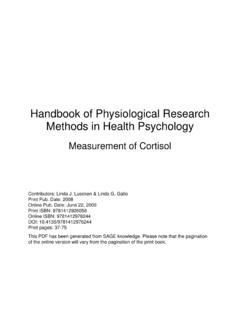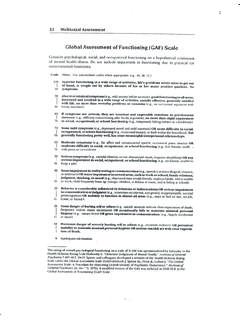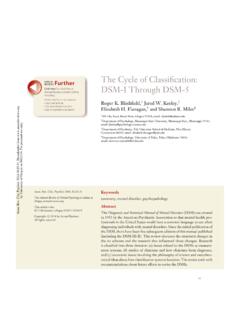Transcription of Neuroimaging: Overview of Methods and Applications
1 1. neuroimaging : Overview of Methods and Applications Lee Ryan, ,3 and Gene E. Alexander, ,3. 1. Cognition and neuroimaging Laboratories, Departments of Psychology and Neurology, University of Arizona, Tucson 2. Neuroimage Analysis Laboratory, Department of Psychology, Arizona State University, Tempe and 3the Arizona Alzheimer's Disease Consortium, AZ. 2007. In L. Luecken and L. Gallo, Eds., Handbook of Physiological research Methods in health Psychology. Elsevier. Corresponding author: Gene E. Alexander, , Department of Psychology, Arizona State University, Tempe, AZ 85287; phone: 480-727-7790; fax: 480-965-8544; email: 2.
2 Introduction The past few decades have seen enormous advances in the ability to visualize and measure aspects of brain anatomy and physiology in the living human being. The recent developments in neuroimaging techniques that provide measures of brain structure and function, as well as cerebral activity during cognitive processes such as perception, attention, and memory have changed the face of cognitive neuroscience, and have allowed us to ask questions about the relation between the brain and behavior that were simply not possible only a decade or two ago. As these techniques have become more accessible and affordable for research use, they have been increasingly applied to a variety of research questions, having the potential to greatly enhance our understanding of the normal brain and its development throughout the lifespan.
3 Even areas of research that have traditionally not been linked to neuroscience, such as social psychology, economics, and education are increasingly making use of neuroimaging Methods . From the beginning, evaluating the effects of health -related factors, such as aging, neurological and psychiatric illness, and brain injury have been an important and rapidly growing part of the neuroimaging field. health psychology provides a potentially unique perspective in the application of neuroimaging Methods studying how brain- behavior relationships are altered by disease states and other health -related factors.
4 neuroimaging provides a set of tools that can address a wide variety of questions. For example, researchers might address how neural systems important for specific cognitive processes are altered by the presence, progression, and treatment of a disease; test the effect of health factors such as genetic risk on regional patterns of 3. brain structure and function; identify subgroups for which treatment or prevention therapies are most effective; or determine the effect of individual differences on the expression, severity, and progression of brain diseases. To utilize these techniques effectively, however, those new to the neuroimaging field and unfamiliar with its rapidly evolving technology are often faced with the daunting task of figuring out where and how to begin.
5 The purpose of this chapter is to provide an Overview of the major neuroimaging Methods and their Applications to health psychology research . Since a detailed and complete description of the Methods and general Applications for neuroimaging in health -related research is well beyond the scope of this chapter, we have focused on the description of Methods and Applications that we believe will provide a useful starting point for researchers who are thinking of applying such neuroimaging techiques to their own areas of health -related psychology. We begin with a brief review of the major structural and functional neuroimaging research Methods that are commonly in use, including computed tomography (CT), magnetic resonance imaging (MRI), positron emission tomography (PET), functional magnetic resonance imaging (fMRI), and diffusion-weighted magnetic resonance imaging (DWMRI).
6 This section will include a brief history of neuroimaging , followed by a description of the origins of the signal that is measured by each method and a discussion of the major benefits and limitations associated with each approach. We will also address general issues and approaches for analysis of neuroimaging data, including a discussion of the use of univariate and novel multivariate Methods . 4. Following our review of the major neuroimaging Methods , we will illustrate how these neuroimaging techniques can be applied to health -related issues, focusing our discussion on Applications to the study of aging and the most common form of age- related dementia, Alzheimer's disease.
7 Finally, we will present a list of suggested readings and websites that provide additional resources and information for those who would like to begin to use these Methods . History of brain imaging Imaging the brain's structure The English scientist Godfrey Hounsfield used a computer to successfully combine a series of conventional X-ray images taken at multiple angles around the head, producing cross-sectional brain images of unprecedented clarity. The first clinical results using X-ray computed tomography (CT) were reported in 1972 (Ambrose &. Hounsfield, 1972a, b), changing overnight the way in which we look at the human brain.
8 Until then, the common method available for brain imaging was also based on X-ray imaging. This method, referred to as pneumoencephalography, was performed by draining cerebrospinal fluid from spaces in and around the brain and replacing it with air, oxygen, or helium to allow the structure of the brain to show up more clearly on conventional X-ray. Although this procedure continued to be performed until the late 1980's, it was painful and posed significant risks for patients. This procedure was supplanted by the CT scan, which could produce higher quality brain images safely and non-invasively. Hounsfield's work on CT not only provided a superior brain imaging method, but also a mathematical technique (tomography or back-projection) where 5.
9 Digital geometric processing is used to generate a three-dimensional image of the internal structure of the brain from a large series of two-dimensional images, and would provide a foundation for the three dimensional reconstruction method used in many imaging Methods that followed. Magnetic resonance imaging (MRI) emerged contemporaneously with CT, but had its roots in the field of nuclear magnetic resonance (NMR). The MRI signal is based on principles of the movement of hydrogen atoms or protons in a magnetic field which were described independently by physicists Felix Bloch (1946) and Edward Purcells (1946) in the 1940's.
10 Their experiments, with a sample of a chemical compound placed in a strong magnetic field, a transmitter coil that sent electromagnetic energy to the sample, and a detector coil that measured energy emitted back from the sample, forms the basis of all modern magnetic resonance imaging. For their work, Bloch and Purcells were jointly awarded the Nobel Prize in Physics in 1952. For many years, NMR's primary application was spectroscopy, or the chemical analysis of samples. In the early 1970's, the American chemist Paul Lauterbur (1973) applied NMR. principles to create a two-dimensional image of an object.




